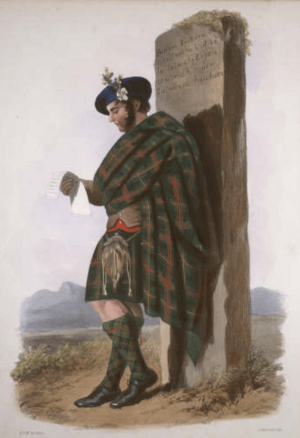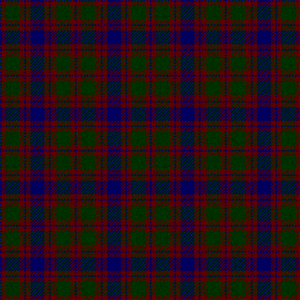Clan Logan facts for kids
Quick facts for kids Clan Logan |
|||
|---|---|---|---|
| Loganach | |||
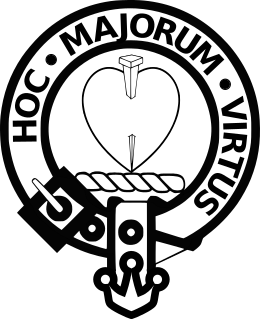
Crest: A passion nail piercing a human heart, Proper
|
|||
| Motto | HOC MAJORUM VIRTUS (Latin: "This is valour of my ancestors"). | ||
| Slogan | Druim-nan-deur (translation from Scottish Gaelic: "The ridge of tears"). | ||
| Profile | |||
| Plant badge | furze (gorse). | ||
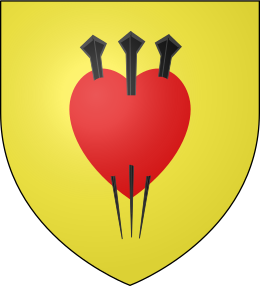 |
|||
| Clan Logan has no chief, and is an armigerous clan | |||
|
|||
Clan Logan is a very old Scottish clan with roots in Celtic history. There are two main groups of Clan Logan. One group is from the Highlands of Scotland. The other group is from the Lowlands. This Lowland group comes from Sir Robert Logan of Restalrig. He married Katherine Stewart, who was a daughter of the future King Robert II. In the year 1400, Sir Robert became the Lord High Admiral of Scotland, a very important naval leader.
Today, Clan Logan does not have a leader officially recognized by the Lord Lyon King of Arms. This means it is considered an armigerous clan. An armigerous clan is a clan that has a coat of arms but no official chief.
Contents
History of Clan Logan
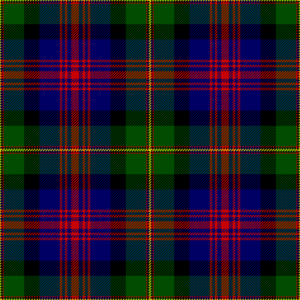
The family name Logan comes from a place. It likely comes from the Gaelic word "Lagan" or "Laggan." This word means "low-lying land," like a valley or a hollow. The Logan family first owned land in areas like Galloway and Dumfriesshire in Scotland. They also lived in Ulster, Ireland, because clans often moved between these places.
Over time, Logans spread across Scotland. They settled in places like Ayrshire, Lanarkshire, and Ross-shire. The Logan family had two main branches. The Grugar (later Restalrig) Logans were the main leaders in the south. The Highland branch, known as Driudeurfit, were leaders in the north. There was also an important group in Lanarkshire.
Today, many people use DNA testing to learn about their family history. The Logan DNA project has found at least 14 different Logan family lines. These lines include Logans from Scotland, Ireland, New Zealand, Australia, Canada, and many other parts of the world. Most Logans were everyday people. They were farmers, business owners, soldiers, sailors, and teachers. While these Logans might not be in history books, the name Logan is now known worldwide. Many airports, towns, counties, and universities are named Logan.
The Northern Logans
The Northern Logan Clan's history can be found on old gravestones. These stones are in Kilmuir Kirkyard. This group was known as the Logans of Drumdeurfit. Their lands were in the Black Isle in Easter Ross-shire. Robert Logan of Druimdeurfit is buried in this cemetery.
The family also lived in other wide areas, even as far as Harris in the Western Hebrides. A woman named Colan Logan was an heiress from Druimmanairig. She married Eachuin Beirach, a son of the Baron of Kintail. He died around 1350, and they had a son named Eanruig. The Logans of Harris came from Eanruig.
From 1372 to 1450, Crotach M'Gillie Gorm was the leader of the Northern Clan Logan. After that, the chiefs were buried in Kilmuir, Western Kirkyard, until 1564. This is written on Thomas Logan's tomb. However, time has worn away the names, so they are hard to read now. Other Logan names there are still clear.
The Lowland Logans
From the 1200s to the 1600s, the Logan family owned much land. They had property in both Scotland and Ulster, Ireland. They were known as brave knights and important landowners. They were famous for their strong courage and loyalty to Scotland. Many Logans died fighting against English invaders. They supported William Wallace and Robert the Bruce in Scotland's fight for independence. They helped with both fighting men and money.
One of the first records of the Logan name is from 1204. Robert Logan witnessed the transfer of land in Ingilbristoun. The name appears often throughout the 1200s. Several Logans paid respect to Edward I of England in 1296. These included Phelippe de Logyn, Thurbrandus de Logyn, Andreu de Logan, and Wautier Logan. Wautier Logan's seal showed a stag's head with a shield between its antlers.
Walter Logan, Lord of Hartside, was a sheriff in Lanark in 1301. In 1298, he received land called "Lus" from Robert Bruce. This Walter Logan was listed twice in 1306. King Edward I took away his lands because he supported Robert the Bruce.
In 1306, Sir Walter Logan was captured by English forces. He was hanged in Durham. This happened in front of Edward of Carnarvon, who would later become King Edward II.
In 1330, two brothers, Sir Robert Logan and Sir Walter Logan, went on a special journey. They were sons of Dominus Walter Logan. They joined Sir James Douglas and others. Their mission was to take the heart of the dead King Robert I of Scotland to the Holy Land. Douglas and his group met Alfonso XI of Castile, a king fighting against the Moors.
During a battle near the Castillo de la Estrella, Douglas saw one of his knights surrounded. He tried to save his countryman. As they were greatly outnumbered, Sir James Douglas took the silver box with Robert Bruce's heart. He threw it among the enemy, saying, "Now pass thou onward before us, as thou wert wont, and I will follow thee or die." Sir James Douglas and most of his men were killed. Sir Robert Logan and Sir Walter Logan also died in this battle.
The main Logan family lived in Lestalrig, or Restalrig, near Edinburgh. Sir Robert Logan of Restalrig married Katherine Stewart. She was a daughter of Robert II of Scotland. In 1400, Sir Robert became the Admiral of Scotland. Sir Robert Logan, Baron of Grugar and the first Logan Baron of Restalrig, was a very important knight. He lived during the reigns of several Scottish kings. His land in Grugar, Ayrshire, came from Sir John de Logan, who owned it in 1302. When Sir John de Lestalric died in 1382, Sir Robert became the first Logan Baron of Restalric.
In 1424, Sir Robert Logan was one of the people given as a hostage. This was to help free James I of Scotland from being held in England. Robert's son or grandson, John Logan of Restalrig, became the main sheriff of Edinburgh. This was decided by James II of Scotland.
In 1555, Logan of Restalrig sold the control of Leith. Leith was the main port for Edinburgh. He sold it to the queen regent, Mary of Lorraine.
The last Sir Robert Logan was the Seventh and Last Baron of Restalric. He was also Baron of Grugar, Fast Castle, and Hutton. He was born in 1555 and died in 1607. He was a very rich man and left a large estate to his children. This last Baron was Robert Logan of Restalrig. He was involved in a famous event called the Gowrie Conspiracy. This event was brought to a Scottish court in 1609, about three years after his death. Scottish law at the time required his body to be in the courtroom. The final decision was that King James I was the wronged party. Logan's children lost their rights and their family wealth went to the King.
The leaders of the Lowland Logan Clan have been traced through history. Alexander Logan was a leader in 1517. He was followed by Patrick Logan of that Ilk in 1531. Then came William Logan of Logan in 1558, and George Logan of that Ilk in 1603. William Logan was a leader in 1633, followed by his son George Logan of Logan. This George Logan officially registered the family's Coat of Arms in 1672. He died in 1756. The line continued with George Logan III of Logan, then his brother Hugh Logan, who died in 1759. The last Logan of Logan, Hugh Logan, was known for his cleverness. He passed away in 1802 without children.
Today, Clan Logan and Clan MacLennan use the same tartan. This tartan was first written about in 1831. It was in a book called The Scottish Gaël by the historian James Logan. Later, in 1845, a book called The Clans of the Scottish Highlands was published. This book had text from Logan and pictures from R. R. McIan. This was the first time the MacLennans were shown using the same tartan as the Logans. The history of Clan Logan in the book suggested an old connection between the two clans. The picture for MacLennan showed a man from that clan wearing the Logan tartan. However, unlike other clan tartans shown, it wasn't given a specific name.
Clan Symbols
Today, Scottish clans use special symbols. These include crest badges, clan badges (plant badges), and tartans. These symbols help represent the clan. The crest badge for Clan Logan members has a special design. It shows a passion nail piercing a human heart. The clan's motto is HOC MAJORUM VIRTUS. This Latin phrase means "this is valour of my ancestors." The plant badge for Clan Logan is furze, also known as gorse. According to Robert Bain, the slogan of Clan Logan is Druim-nan-deur. This Scottish Gaelic phrase means "the ridge of tears."
The tartan most often linked to the name Logan is the same as Clan MacLennan's. This pattern was first published in James Logan's The Scottish Gaël in 1831. However, there are older tartans that are also connected to the name Logan. One such tartan is usually called a Skene tartan. It has also sometimes been known as a Rose tartan. The official state tartan of Utah is based on this tartan. This is to honor Ephraim Logan, who is thought to be the first American of Scottish descent to make a lasting mark on Utah.
Clan Logan in Stories
In the TV show Law & Order, there is a character named Detective Mike Logan. He learns that in his family's old home in Ireland, there are only two people with the Logan last name. One is the local priest. The other is his brother, who owns a pub and a funeral parlor.


